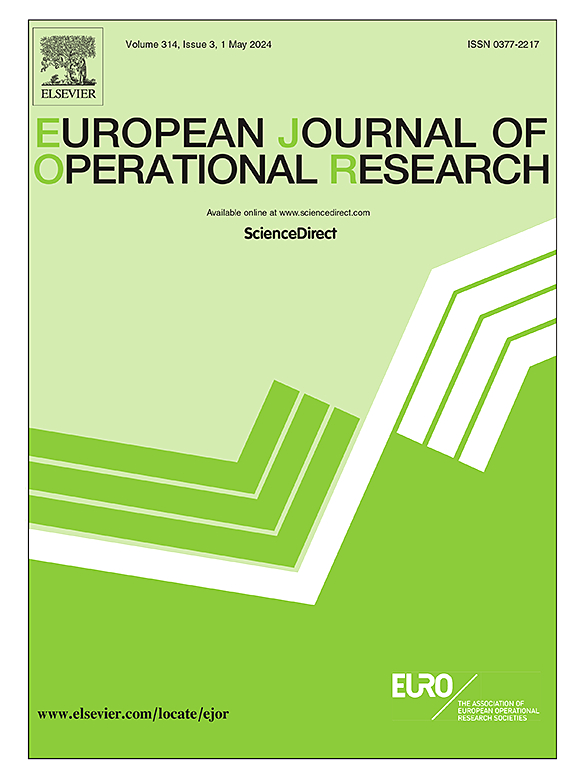Integrated estimate-and-optimize decision trees learning for two-stage linear decision-making problems
IF 6
2区 管理学
Q1 OPERATIONS RESEARCH & MANAGEMENT SCIENCE
引用次数: 0
Abstract
Several decision-making under uncertainty problems found in industry and the scientific community can be framed as stochastic programs. Traditionally, these problems are addressed using a sequential two-step process, referred to as predict/estimate-then-optimize, in which a predictive distribution of the uncertain parameters is firstly estimated and then used to prescribe a decision. However, most predictive methods focus on minimizing forecast error, without accounting for its impact on decision quality. Moreover, practitioners often emphasize that their main goal is to obtain near-optimal solutions with minimum decision error, rather than least-error predictions. Therefore, in this work, we discuss a new framework for integrating prediction and prescription into the predictive distribution estimation process to be subsequently used to devise a decision. We particularly focus on decision trees and study decision-making problems representable as contextual two-stage linear programs. Firstly, we propose a workable framework along with a non-convex optimization model to account for the impact of the underlying decision-making problem on the predictive distribution estimation process. Then, we recast the non-convex model as a Mixed-Integer Programming (MIP) problem. Acknowledging the difficulty of the MIP reformulation to scale to large-scale instances, we devise a computationally efficient Heuristic strategy for the estimation problem leveraging the structure intrinsic to decision trees. A key feature of the proposed decision-making framework is its ability to instantly assess decisions by mapping new contexts to a leaf and retrieving the precomputed solution of the corresponding two-stage problem. A set of numerical experiments is conducted to illustrate the capability and effectiveness of the proposed framework using three distinct two-stage decision-making problems. We benchmark the proposed approach against prescriptions devised by various alternative frameworks. Five predict/estimate-then-optimize benchmarks that rely on commonly used predictive and distribution estimation methods and three benchmarks based on integrated predict-and-optimize decision-making processes are considered. We focus on evaluating solution quality and the computational performance of the MIP reformulation.两阶段线性决策问题的综合估计与优化决策树学习
工业和科学界中存在的一些不确定性问题下的决策可以用随机规划来描述。传统上,这些问题是通过一个连续的两步过程来解决的,称为预测/估计-然后优化,在这个过程中,首先估计不确定参数的预测分布,然后使用它来规定决策。然而,大多数预测方法侧重于最小化预测误差,而没有考虑其对决策质量的影响。此外,从业者经常强调他们的主要目标是以最小的决策错误获得接近最优的解决方案,而不是最少的错误预测。因此,在这项工作中,我们讨论了一个新的框架,将预测和处方集成到预测分布估计过程中,随后用于设计决策。我们特别关注决策树和研究决策问题可表示为上下文两阶段线性规划。首先,我们提出了一个可行的框架以及一个非凸优化模型,以考虑潜在决策问题对预测分布估计过程的影响。然后,我们将非凸模型转化为一个混合整数规划问题。考虑到MIP重新表述扩展到大规模实例的困难,我们设计了一种计算效率高的启发式策略,用于利用决策树固有的结构来估计问题。所提出的决策框架的一个关键特征是它能够通过将新的上下文映射到叶子并检索相应的两阶段问题的预先计算的解决方案来立即评估决策。通过三种不同的两阶段决策问题,进行了一组数值实验来说明所提出的框架的能力和有效性。我们将建议的方法与各种替代框架设计的处方进行比较。考虑了五种基于常用预测和分布估计方法的预测/估计-然后优化基准和三种基于综合预测和优化决策过程的基准。我们的重点是评估解决方案的质量和计算性能的MIP重组。
本文章由计算机程序翻译,如有差异,请以英文原文为准。
求助全文
约1分钟内获得全文
求助全文
来源期刊

European Journal of Operational Research
管理科学-运筹学与管理科学
CiteScore
11.90
自引率
9.40%
发文量
786
审稿时长
8.2 months
期刊介绍:
The European Journal of Operational Research (EJOR) publishes high quality, original papers that contribute to the methodology of operational research (OR) and to the practice of decision making.
 求助内容:
求助内容: 应助结果提醒方式:
应助结果提醒方式:


